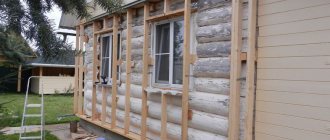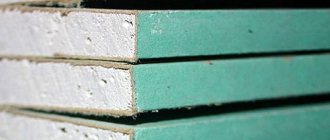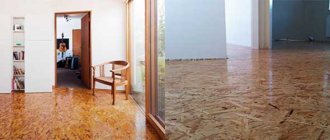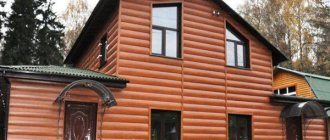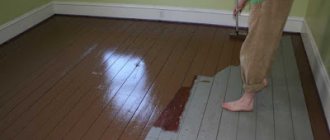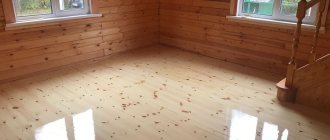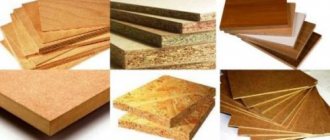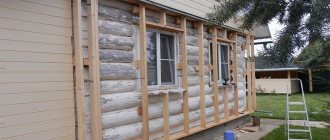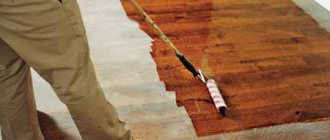How to putty walls made of cemented wood?
Puttying DSP
We use elastic putty
, as when working with drywall. We process the edges with an edge plane. Do not remove the layer of material too deeply; the chamfer should be removed at a ratio of 1:3 in relation to the thickness of the slab. The removal angle is 45 degrees.
Interesting materials:
Which gas in the air contains the most oxygen and carbon dioxide? What gas is in the air? What continent did the Vikings reach in their campaigns in the 10th century? What is the origin of lake basins? How tall was Alyosha Popovich? How tall were the Russian heroes? What color was the Kremlin originally? What color was the Winter Palace? What color is quartz? What color are roses?
Fastening cement bonded particle boards to a wooden frame
need to be prepared before attaching the slats to the façade. They beat off weak points and open up cracks. If the dowel gets into an unreinforced layer, the sheathing will wobble. Install the insulation on the wall, the material is fixed with dowels with wide caps (mushrooms).
Further actions:
- over the entire wall area attach the frame sheathingFor this purpose, galvanized profiles or wooden blocks treated with drying oil are used;
- during the installation process , verticality and horizontality are adjusted , a flat surface is formed in order to attach the DSP to the wooden frame without distortions;
- install windproof membrane so that there is a gap of at least 1 - 1.5 cm between it and the insulation;
- You cannot drill into the DSP directly with a self-tapping screw; you must first make holes in the panel with a diameter 0.5 mm smaller than the diameter of the hardware.
Valera
The voice of the construction guru
Ask a Question
The holes are made no closer than 10 mm from the edge with a pitch of 45 - 50 cm. The DSP sheets are fastened so that there is a gap of about 5 mm between them, which will subsequently be sealed with sealant. Countersink holes are made under the heads so that they are hidden in the body of the slab.
Fasteners for CBPB
More often, panels are fixed to frame elements using nails and self-tapping screws . Anchor bolts are used to fix the racks and cross members of the frame sheathing to the wall of the building.
The bolts can be metal or plastic, and the screws in them can be twisted or driven in. The length is chosen so that the hardware extends 40 - 50 mm into the concrete or brick. To fasten other parts, various hardware :
- Brackets and hangers from the drywall fastening system. With their help, wooden slats are leveled in a plane and verticality is coordinated.
- Self-tapping screw "flea" . Used when installing a frame made of galvanized profiles to connect metal profiles with hangers. In the case of wooden sheathing, wood screws are used.
- Dowel mushroom . These types of fasteners with large heads secure roll insulation, for example, mineral wool.
Valera
The voice of the construction guru
Ask a Question
Nails are used with a helical surface of the rod. If the slab moves after being secured, the nail may bend but will not cut it off. This is especially important for roof slopes if they are on a slight slope. The length of the hardware is taken so that it is 2.5 times the thickness of the DSP.
Manufacturing features and main advantages of this group of products
As the name suggests, the basis for production is cement and shavings; let’s look at the composition in a little more detail:
Such boards are not afraid of a humid environment, temperature changes, mold, chemical influences and therefore are used for a wide range of works:
In the photo - covering the house with cement bonded particle board allows you to carry out work as quickly as possible
DSP is an excellent base for any floor covering
Important! The material has been tested, and its safety for human health has been confirmed both in our country and abroad: in the European Union, the USA, and so on.
DSP: features when working with slabs and installation recommendations
Wood panels have gained wide popularity in construction. Along with undeniable advantages (ease of processing and installation, availability), wood-composite materials also have disadvantages. These include poor water resistance, deformation and delamination upon contact with moisture, as well as the content of harmful formaldehyde resins. To avoid these negative features, cement bonded particle boards were created. In the article “DSP classification, selection and scope of application” we have already examined the main properties of this material; in this publication we will talk about the features of the operation and installation of DSP.
Construction of a frame house
The technology of frame houses has recently gained wide popularity. The main advantages are the speed of construction and the availability of materials. There is also a place for DSP in this matter. OSB (OSB) is considered more common in this area - oriented strand board. OSB is often cheaper in cost than cement board, but cement board is more environmentally friendly, since it does not contain harmful resins. Also, cement products have high moisture resistance, while oriented strand board begins to deform when exposed to moisture. For all these reasons, DSP can be used in frame house construction.
The frame is the “skeleton” of the house; it is covered with panels that form the strength body of the building and provide thermal insulation. These panels are sometimes called “pie” because they are made up of many layers. There are a large number of panel layout variations. Sometimes the DSP is fixed on the frame itself, then there is a layer of vapor barrier, a sheathing made of timber, between which the insulation is attached. On the outside, the “pie” is completed by another outer sheet of DSP. The thickness of the sheets can vary from 10 to 16 mm. Moreover, if the house is multi-story, then block and beam structures will be required to lift the sheets to the height of the second floor. Holes for self-tapping screws are also made in advance. Fasteners are installed every 15 cm. In the central part of the sheet, fastening every 30 cm is allowed. One slab should fit three sheathing posts. Do not forget about the expansion joint, which is filled with sealant to protect the heat insulator.
House frame covered with DSP sheets
Application of decorative plaster
Decorative plaster can also be considered a relatively young technology, but, unlike elastic plaster, it is extremely popular as a finishing material for a wide variety of surfaces. Decorative plaster in frame houses can be applied in one layer without a base. This is possible in cases where a finishing coating will be installed on top of it: ceramic tiles, natural stone, etc. Thus, the plaster itself will be the first layer of finishing. In addition, the plaster can be painted and varnished.
Modern decorative plasters are such that they combine excellent appearance with protective properties. However, if your house is being built in difficult climatic conditions, you can additionally treat its walls with special compounds. As a last resort, you can treat only the side that is in the sun or most often exposed to rain. But keep in mind that additional coatings can worsen the gas permeability of the walls, which does not happen when covering only one decorative plaster.
Still have questions? Do you want to order a project calculation? Leave a request!
Basic criteria for selecting paint and carrying out painting work
As you can understand from the previous chapter, the material, in principle, does not need additional protection - the surface is already resistant to various adverse influences and can serve for many years. But from an aesthetic point of view, gray color is not suitable for every building, and you want to change something in the design from time to time. The material is suitable for coloring, but it is important to choose the right composition.
What colors are suitable?
Let's consider how to paint a DSP board so that the coating lasts for a long time:
An excellent option is wear-resistant solutions, they are especially good for finishing floor coverings
Latex-based composites are an excellent solution for protecting external walls
Caparol's products have earned an excellent reputation due to the high quality of their formulations
It is worth noting that painting CBPB with alkyd-based compounds is not allowed - they react very poorly to alkalis, which leads to unpredictable results; the coating can crack or even peel off in a very short time.
And one more important note: to save paint and achieve the best result, it is best to pre-treat the material with an acrylate primer. It penetrates deeply into the surface, strengthening it and reducing absorbency. The adhesion of paint and base is also significantly improved, while the price of the composition is quite affordable.
Acrylate primer is the best preparation for cement bonded particle boards for painting
Features of base preparation
As part of surface preparation, the following activities are carried out:
Coloring
Painting a private house
Advice! Manufacturers do not recommend painting in the first six months after installation - natural influences will naturally clean the surface and prepare it for painting.
Painting of DSP - features of choosing the composition and carrying out the work
Cement particle board or, as it is abbreviated as CSP, appeared relatively recently, but is already actively used for a wide variety of types of work. All this is due to a number of advantages that are appreciated by both private developers and industrial enterprises.
In this regard, the question arose of what to paint DSP with and how to do it correctly; this is what this review will be devoted to.
Cement particle boards are an excellent finishing material
Distinctive features
How did a material such as DSP deserve its popularity? The characteristics that manufacturers describe their product are as follows:
- Absolute safety, both for humans and for nature.
- Resistance to mechanical damage (even with a strong impact it is very difficult to damage the installed slab).
- Low coefficient of absorbed moisture.
- Passes steam well.
- Has excellent soundproofing properties.
- It is not susceptible to rotting even in constant conditions of high humidity.
- Frost resistance.
- This is a material that does not spread flame on its surface and does not emit caustic substances when exposed to high temperatures.
These positive aspects make it possible to perfectly install DSP on the façade.
Plaster on mesh
Plastering a frame house over a metal mesh is another popular option for exterior finishing of a house. The mesh for this procedure must be steel; it is attached to the frame using staples, screws or nails. For walls of a small area, you can take a mesh in the form of a continuous canvas, which must be supported by a vertical or horizontal corner so that it does not sag in the middle and does not touch the cladding of the house. At the corners the mesh is closed with a steel angle, or its ends simply overlap each other. A metal strip is nailed to the bottom of the wall, which secures the mesh and serves as a support for applying plaster. If the mesh is installed without sagging, then the likelihood of cracks appearing when applying plaster will be minimal.
Applying plaster over metal mesh is quite simple. To increase strength, fiber fibers are added to the solution. The primary plaster is applied in a fairly thick layer (up to 2 cm), but there is no need to level it too carefully. The first layer dries within two days at a temperature of at least 18 degrees above zero. At lower temperatures, the drying time should be extended by another day. When this layer has dried, a plastic mesh should be installed on it and a finishing layer of decorative plaster should be applied. It differs from the substrate only in the absence of fiber fibers in the mixture and in a thinner layer. If you plan to paint the wall in the future, the top layer should be leveled. The total thickness of all layers on top of the OSB board should be a little over two centimeters. This value ensures the strength of the structure and does not weigh down the house.
Installation of a curtain facade
One of the common ways to use DSP is as a curtain wall, which allows you to insulate, increase sound insulation, level the wall of a house and protect it from the aggressive influence of the external environment. Curtain facades are used for brick or wooden houses. It has a multilayer structure, which consists of different layers.
Various types of brackets, the third has an adjustable length for leveling the curtain wall
Lathing options for attaching a curtain wall façade for CBPB
To level the wall, two brackets are fixed to two anchor bolts, the level between which is measured with a rope (mooring); a hydraulic level . This is a measuring device that works on the principle of connected vessels.
The hydraulic level consists of two containers with scales, which are connected by a transparent tube. The containers are filled with colored liquid. Two people are required to operate this measuring device. It is necessary to ensure that the liquid in both containers is at the same level on the scales.
lines are hung on the upper brackets for beating the wall vertically. The length of all other brackets is set relative to the plumb line. When the levels are installed, the brackets are fixed in increments of no more than 600 mm.
Preparing for finishing
Often, houses lined with DSP are painted or plastered directly on top of the slabs; this type of finishing is very simple and convenient. Thanks to the even geometry of the sheets, the paint will adhere well after simple preparatory procedures. Good adhesion ensures easy adhesion of the finish coat.
Painted frame house in fechwerk style
